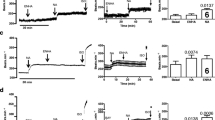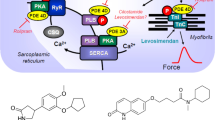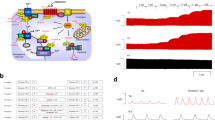Summary
-
(1)
This study was performed to elucidate the relation between positive inotropy and phosphodiesterase inhibition in the heart. Therefore, the influence on the activity of guinea-pig cardiac phosphodiesterase (PDE) I–III separated by DEAE-cellulose anion exchange chromatography was investigated for the new cardiotonic agents pimobendan, its metabolite UD-CG 212 Cl and milrinone. These effects were compared with those of various other PDE inhibitiors such as IBMX, zaprinast, rolipram and AR-L 57 Cl. A selectivity factor (SF, mean of the IC50 values for PDE I and II inhibition divided by the IC50 for PDE III) was calculated for each drug. The greater this value the more selective was the PDE III inhibition.
-
(2)
UD-CG 212 Cl was the most potent (IC50 = 0.19 μmol/l) and most selective inhibitor of PDE III with a SF of 869. Also, selective PDE III inhibitors were pimobendan (SF = 50.5) and milrinone (SF = 70.0) with slightly smaller potencies (IC50 = 2.40 and 1.52 μmol/l, respectively). Zaprinast and rolipram preferentially inhibited PDE I and II, respectively. IBMX and AR-L 57 Cl inhibited PDE I-111 unselectively with similar potencies for all isoenzymes.
-
(3)
The PDE inhibitory effects of all substances were compared with their influence on force of contraction (electrically driven papillary muscles) and on frequency of beating (spontaneously beating right auricles) in guinea-pig hearts, thus in preparations of the same species. UD-CG 212 Cl and pimobendan resembled each other in their maximal positive inotropic effects with potencies (EC50) of 1.8 μmol/l and 6.0 μmol/l, respectively. Milrinone exerted a biphasic increase in force of contraction with EC5o values of 0.2 and 695 μmol/l. These substances which selectively inhibited PDE III increased force of contraction maximally by 2.04 mN (UD-CG 212 Cl), 2.77 mN (pimobendan) and 3.29 mN (milrinone). Milrinone increased the frequency of beating by 40%, pimobendan by 22% and UD-CG 212 Cl by 16% at maximal positive inotropic concentrations.
-
(4)
The unselective PDE I-III inhibitors IBMX and AR-L 57 Cl increased force of contraction with the highest maximal effects (5.9 mN and 4.23 mN, respectively). There was no correlation between EC5o values for the positive inotropic effects and IC50 values for the inhibition of PDE I–III. Zaprinast exerted only weak (0.87 mN) and rolipram no effects on force of contraction. The latter substances had no positive chronotropic effects.
-
(5)
In conclusion, the positive inotropic effects of the new cardiotonic agents pimobendan, UD-CG 212 Cl and milrinone may be at least in part due to selective cardiac PDE III inhibition. For UD-CG 212 Cl and pimobendan the IC50 for PDE III inhibition and the EC50 for the positive inotropic effects were of the same order of magnitude. For milrinone, only the lower EC50 value is similar to the IC50 for the inhibition of PDE III. In the case of the unselective PDE III inhibitors IBMX and AR-1. 57 Cl a factor of 20 was found between potencies for positive inotropy and PDE III inhibition. Thus, PDE III inhibition seems to be a prerequisite for PDE inhibition as a mechanism of action for increasing force of contraction. However, the pronounced positive inotropic effects of IBMX and AR-L 57 Cl provide evidence that a selectivity for PDE III inhibition seems not to be essential for increasing force of contraction. Finally, there is no indication that inhibition of PDE I or II plays a major role in increasing force of contraction.
Similar content being viewed by others
References
Alousi AA, Johnson DJ (1986) Pharmacology of the bipyridines: amrinone and milrinone. Circulation 73 (Suppl III):III-10-III-24
Berger C, Meyer W, Scholz H, Starbatty J (1985) Effects of the benzimidazole derivatives pimobendan and 2-(4-hydroxyphenyl)-5-(5-methyl-3-oxo-4,5-dihydro-2H-6-pyridazinyl) benzimidazole · HCI on phosphodiesterase activity and on force of contraction in guinea-pig hearts. Arzneimittelforschung 35:1668–1673
Bergstrand H, Kristoffersson J, Lundquist B, Schurmann A (1977) Effects of antiallergic agents, compound 48/80, some reference inhibitors on the activity of partially purified human lung tissue adenosine cyclic 3′,5′-monophosphate and guanosine cyclic 3′,5′-monophosphate phosphodiesterases. Mol Pharmacol 13: 38–43
Bethke Th, Brunkhorst D, v. der Leyen H, Meyer W, Nigbur R, Scholz H (1988) Mechanism of action and cardiotonic activity of a new phosphodiesterase inhibitor, the benzimidazole derivative adibendan (BM 14.478), in guinea-pig hearts. Naunyn-Schmiedeberg's Arch Pharmacol 337:576–582
Bradford M (1976) A rapid and sensitive method for the quantitation of microgram quantities of protein utilizing the principle of protein-dye binding. Anal Biochem 72:248–254
Brown L, Näbauer M, Erdmann E (1986) The positive inotropic response to milrinone in isolated human and guinea pig myocardium. Naunyn-Schmiedeberg's Arch Pharmacol 334:196–201
Colucci WS, Wright RF, Braunwald E (1986) New positive inotropic agents in the treatment of congestive heart failure. N Engl J Med 314:290–299, 349–358
Diederen W, Kadatz R (1981) Comparative cardiovascular effects of three benzimidazole derivatives, AR-L 57 BS, AR-L 100 BS and AR-L 115 BS. Arzneimittelforschung 31:141–146
Duncker DJ, van Dalen FJ, Hartog JM, Lamers JMJ, Rensen RJ, Saxena PR, Verdouw PD (1986) Usefullness of pimobendan in the treatment of heart failure. Arzneimittelforschung 36:1740–1744
England PJ, Leigh BK, Reeves ML (1986) Identification and selective inhibition of a new phosphodiesterase activity from cat cardiac ventricle. Br J Pharmacol 89:572P
Erhardt PW (1987) In search of the digitalis replacement. J Med Chem 30:231–237
Farah AE, Canniff PC, Bentley R, Kaiser LD (1987) Effect of milrinone (CorotropeR) on the contractility of isolated dog ventricular muscle. J Cardiovasc Pharmacol 10:607–615
Freund P, Bartsch W, Grünewald M, Meboldt U, Kling L (1987) Calcium sensitizing and PDE-inhibiting action of the novel cardiotonic BM 14.478 — a comparison with other new compounds. Naunyn-Schmiedeberg's Arch Pharmacol 335:R57
Fujino K, Sperelakis N, Solaro RJ (1988) Sensitization of dog and guinea pig heart myoflaments to Ca2+ activation and the inotropic effect of pimobendan: comparison with milrinone. Circ Res 63:911–922
Hayes JS, Bowling N, Boder GB, Kauffman R (1984) Molecular basis for the cardiovascular activitites of amrinone and AR-L 57. J Pharmacol Exp Ther 230:124–132
Hayes JS, Wyss VL, Wilson H, Pollock GD (1985) A comparison of the cardiotonic effects of AR-L 115 and AR-L 57: evidence for distinct inotropic mechanisms. J Cardiovasc Pharmacol 7:182–189
Harrison SA, Reifsnyder DH, Gallis B, Cadd GG, Beavo JA (1986) Isolation and characterization of bovine cardiac muscle cGMP-inhibited phosphodiesterase: a receptor for new cardiotonic drugs. Mol Pharmacol 29:506–514
Honerjäger P, Heiss A, Schäfer-Korting M, Schönsteiner G, Reiter M (1984) UD-CG 115 — a cardiotonic pyridazinone which elevates cyclic AMP and prolongs the action potential in guineapig papillary muscle. Naunyn-Schmiedeberg's Arch Pharmacol 325:259–269
Korth M (1978) Effects of several phosphodiesterase-inhibitors on guinea-pig myocardium. Naunyn-Schmiedeberg's Arch Pharmacol 302:77–86
van Meel JCA (1987) Effects of some cardiotonic agents on contractility of skinned fibers from mammalian heart. Arzneimittelforschung 37:679–682
Reeves ML, Leigh BK, England PJ (1987) The identification of a new cyclic nucleotide phosphodiesterase activity in human and guinea-pig cardiac ventricle. Biochem J 241:535–541
Rüegg JC, Pfitzer G, Eubler D, Zeugner C (1984) Effect on contractility of skinned fibres from mammalian heart and smooth muscle by a new benzimidazole derivative, 4,5,-dihydro-6-[2-(4-methoxyphenyl)-1H-benzimidazol-5-yl]-5-methyl-3(2H)-pyridazinone. Arzneimittelforschung 34:1736–1738
Rüegg JC (1986) Effects of new inotropic agents on Ca2+ sensitivity of contractile proteins. Circulation 73 (Suppl III): III-78-III-83
Scholz H, Meyer W (1986) Phosphodiesterase-inhibiting properties of newer inotropic agents. Circulation 73 (Suppl III): III-99-III-106
Schwabe U, Miyake M, Ohga Y, Daly JW (1976) 4-(3-cyclopentyloxy-4-methoxyphenyl)-2-pyrrolidone (ZK 62711): a potent inhibitor of adenosine cyclic 3′,5′-monophosphate phosphodiesterases in homogenates and tissue slices from rat brain. Mol Pharmacol 12:900–910
Siegl PKS (1986) Overview of cardiac inotropic mechanism. J Cardiovasc Pharmacol 8 (Suppl 9):S1-S10
Thompson WJ, Terasaki WL, Epstein PM, Strada SJ (1979) Assay of cyclic nucleotide phosphodiesterase and resolution of multiple molecular forms of the enzyme. Adv Cyclic Nucleotide Res 10:69–92
Weishaar RE, Cain MH, Bristol JA (1985) A new generation of phosphodiesterase inhibitors: multiple molecular forms of phosphodiesterase and the potential for drug selectivity. J Med Chem 28:537–545
Weishaar RE, Burrows SD, Kobylarz DC, Quade MM, Evans DB (1986) Multiple molecular forms of cyclic nucleotide phosphodiesterase in cardiac and smooth muscle and in platelets. Biochem Pharmacol 35:787–800
Weishaar RE, Kobylarz-Singer DC, Steffen RP, Kaplan HR (1987) Subclasses of cyclic AMP-specific phosphodiesterase in left ventricular muscle and their involvement in regulating myocardial contractility. Circ Res 61:539–547
Author information
Authors and Affiliations
Additional information
Send offprint requests to H. v. der Leyen at the above address
Rights and permissions
About this article
Cite this article
Brunkhorst, D., v. der Leyen, H., Meyer, W. et al. Relation of positive inotropic and chronotropic effects of pimobendan, UD-CG 212 Cl, milrinone and other phosphodiesterase inhibitors to phosphodiesterase III inhibition in guinea-pig heart. Naunyn-Schmiedeberg's Arch Pharmacol 339, 575–583 (1989). https://doi.org/10.1007/BF00167264
Received:
Accepted:
Issue Date:
DOI: https://doi.org/10.1007/BF00167264




